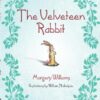Description
The Rabbit in the stocking is not as expensive as the other toys: he’s covered in velveteen. On Christmas Day, the Boy enjoys his new toy but then quickly forgets and neglects him. Shunned and unsure, the Velveteen Rabbit questions his worth. Will have to he even becalled a real toy? An answer comes from his friend, the Skin Horse: “Real isn’t how you are made. . . .It is a thing that happens to you. When a child loves you for a long, long time, not just to play with, but REALLY loves you, then you grow to be Real.” The Velveteen Rabbit’s journey through love and loneliness to grow to be who he was once in reality meant to be is a story that inspires us all on our own journey to Real.
The Velveteen Rabbit is a timeless tale of friendship, love, acceptance and honesty. When the world seems uncertain, Margery Williams’s classic story reminds all of us what in reality matters.
The type in this edition has been reset to emphasize the poetry of the language and to bring out the depth of sentiment in the story. William Nicholson’s 1922 illustrations, which have delighted generations of readers, are rendered in full-color just as they appeared in the original edition of The Velveteen Rabbit. Together words and pictures create a world such a lot like our own, and yet so delightfully magical.
A stuffed toy rabbit (with real thread whiskers) comes to life in Margery Williams’s timeless tale of the transformative power of love. Given as a Christmas gift to a young boy, the Velveteen Rabbit lives in the nursery with the entire other toys, waiting for the day when the Boy (as he is known as) will make a selection him as a playmate. In time, the shy Rabbit befriends the tattered Skin Horse, the wisest resident of the nursery, who reveals the goal of all nursery toys: to be made “real” through the love of a human. “‘Real is not how you are made,’ said the Skin Horse. ‘It is a thing that happens to you. When a child loves you for a long, long time, not just to play with, but REALLY loves you, then you grow to be Real.'” This sentimental classic–perfect for any child who’s ever thought that maybe, just maybe, his or her toys have feelings–has been charming children since its first publication in 1922. (A great read-aloud for all ages, but children ages 8 and up can read it on their own.)








Reviews
There are no reviews yet.